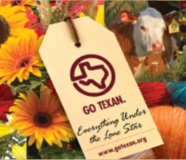|
Thanksgiving is an American holiday loaded with tradition, so why not start a new tradition by making Thanksgiving an eco-friendly celebration? There are simple steps you can take to make your holidays more environmentally conscience:
Food waste accounts for 18 percent of municipal solid waste sent to landfills. That’s over 30 million tons of food waste each year! Reduce food consumption with better planning. Know how many people you expect to feed and what their preferences are. Reuse already-cooked food in another recipe. Leftover turkey is great for soups and casseroles. Recycle food by composting. If you don’t already have a compost bin, use your Thanksgiving fruit and vegetable trimmings to start one. Find instructions in the free Take Care of Texas guide to Mulching and Composting.
 Get the freshest possible ingredients for your mashed potatoes and pumpkin pies by visiting your local farmer’s market. If you can’t find a farmer’s market in your area, try to purchase as many Texas-grown ingredients at the grocery store as you can. Buying locally grown food supports the local economy, reduces emissions from refrigeration and transportation, and cuts back on packing materials.
|
Cook with ceramic pots and pans. Compared to traditional nonstick pans coated with Teflon, pots and pans made with ceramic-based nonstick technology take less time to heat the surface, because of the excellent heat conductivity of the aluminum they are made from. Cast-iron and glass cookware also retain heat well and minimize preheating time – conserving energy. You can also conserve energy by using your microwave. An oven requires enough energy to heat the entire compartment, but a microwave only needs energy to heat the food.
Find other ways to conserve and recycle in your kitchen on the Take Care of Texas website.
Texas Recycles Day is Saturday, November 15. As a community leader, teacher, or employee, pick a project this Recycles Day, and encourage those around you to join. Make it easy for them. Provide clear and easy steps for them to participate, and explain why it’s important. Good luck!
Recycle for charity.
Goodwill accepts shirts, shoes, blankets, electronics, and other items for resale. When someone later buys your items, Goodwill uses that money to fund job training and other services in your local community.
Recycling for Charities collects old wireless cell phones, PDA’s, iPods, and digital cameras and in turn donates money to your favorite charity. Options include nationwide organizations such as American Red Cross and Special Olympics as well as local animal shelters and churches. If the items cannot be reused, Recycling for Charities will break down and separate components for resale. No items they collect will end up in a landfill.
Have a pair of eyeglasses in your junk drawer? Donate them to a charity such as Lions Club or Eyes of Hope, and they will distribute them to people that cannot afford eyewear. Give others the gift of sight so that that they can be more successful at school and work.
Recycle for Rewards.
Some companies offer money back for donating items you no longer use. Apple’s Recycling Program and the AT&T Trade-in Program, for example, allow you to send them your old devices for free. Depending on the condition and market for those items, you could receive money or gift cards in return. Have a cluttered bookshelf? Half Price Books gives you cash on spot for your unwanted books.
Get creative.
Turn glass bottles into your favorite candle holders, flower pots, or soap dispensers. Make magnets out of bottle caps or broken jewelry. Get with the kids, and make bird feeders out of tin cans or milk cartons. The options are limitless.
Companies have gotten creative, too. Nike has several programs that focus on sustainability, including Reuse-A-Shoe that grinds down worn out athletic shoes and recycles the parts. The shoe’s outsole turns into rubber for running tracks and playground surfaces, and the midsole can be made into cushion for basketball and tennis courts. Nike has also diverted over two billion plastic bottles from landfills by transforming plastic bottles into polyester that is woven into premium fabric for performance apparel. On average, nine recycled bottles emerge as a jersey.
Clean Out Your Closet
 As cool weather settles in and a heavier layer of clothing is pulled from the back of our closets, you might wonder what options you have for worn or outgrown clothing. You might be surprised at what you don’t know:
|
There’s a lot of it: The EPA estimates around 5 percent of all household waste is textiles, in the realm of 14 million tons!
There are multiple players: Manufacturers like Nike have long-standing programs like the Reuse-A-Shoe program listed above, and other brands are getting on board too. Still, the most universally available source for the secondhand clothing market are community charitable organizations.
It’s more than clothes: Reuse and recycling options exist for more than just clothes: worn or outgrown shoes, sheets, and undergarments like socks are a valuable source of fiber and material.
It doesn’t have to be pristine: Did you know that for items that can’t be sold (such as The Hulk’s tattered t-shirt) or do not sell quickly, most charitable organizations have textile-specific recyclers who accept their merchandise in bulk and ship to other reuse markets or recycle the material?
That means even if there is a hole, stain, or if the socks and pillow cases have seen better days, the material itself can still be useful for conversion into recycled rags, or postconsumer fiber (for insulation, carpet padding, etc.). This applies to shoes: worn soles or perhaps a shoe whose mate is missing. So make sure your donation is dry and consider adding things to the bag that you wouldn’t have otherwise!
For more information about the life cycle of secondhand clothing visit the Council for Textile Recycling’s website <http://www.weardonaterecycle.org/about/clothing-life-cycle.html>. Remember: Reduce, Reuse, then Recycle.
|